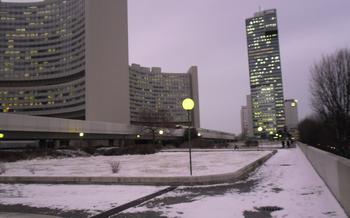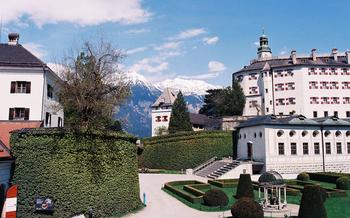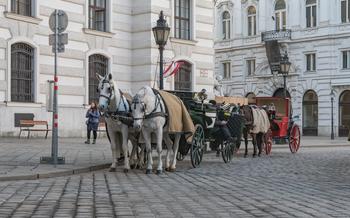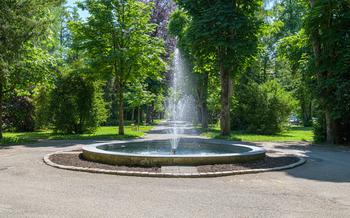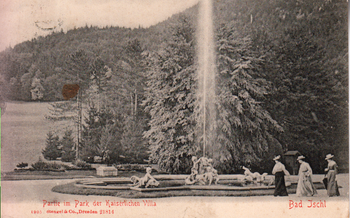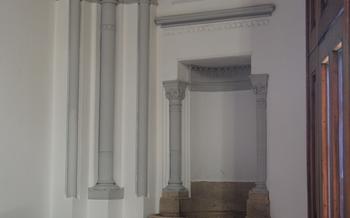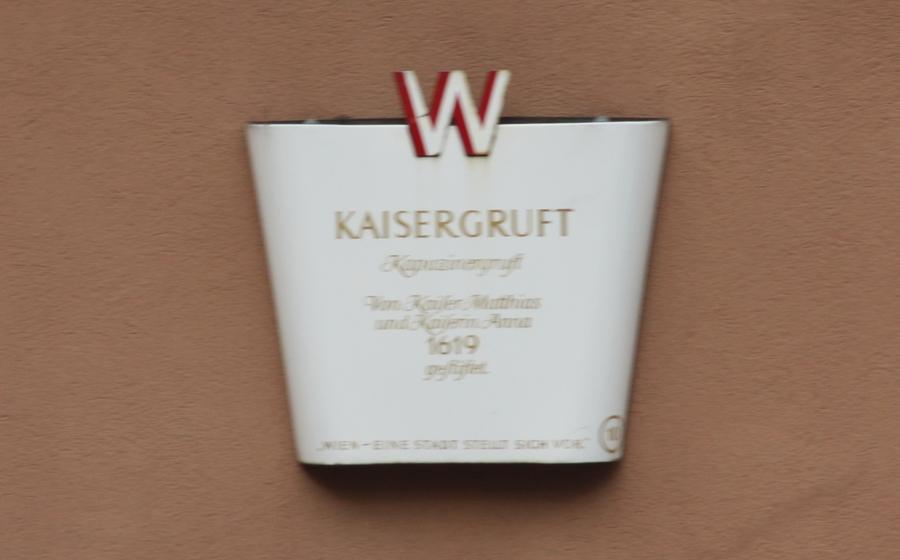
The Imperial Crypt
- A Majestic Final Resting Place
- Unveiling the Habsburg Legacy
- Exploring the Capuchin Crypt
- The Imperial Vaults: Majestic Repose for Habsburg Rulers
- The Double Sarcophagus
- The Heart Crypt
- Imperial Burials Throughout History
- The Imperial Crypt Museum
- A Walk Through History
- The Crypt as a Tourist Destination
- The Habsburg Family Tree
- Symbolism and Iconography
- Restoration and Preservation:
A Majestic Final Resting Place
Deep beneath the bustling streets of Vienna lies a hidden gem that holds the earthly remains of some of history's most powerful rulers: the Imperial Crypt. This grand subterranean chamber, located beneath the Capuchin Church, serves as the final resting place for the Habsburg dynasty, who ruled over Austria for over six centuries.
The Imperial Crypt is not just a burial site but a testament to the grandeur and opulence of the Habsburg dynasty. Its architectural features, designed by Johann Bernhard Fischer von Erlach, are a stunning blend of Baroque and Renaissance styles, featuring intricate carvings, elaborate frescoes, and gleaming marble.
Among the notable burials within the crypt are Emperor Franz Joseph I, Empress Elisabeth (Sisi), and Empress Maria Theresa. Each sarcophagus tells a unique story, offering a glimpse into the lives and reigns of these iconic figures. The Imperial Crypt stands as a symbol of Habsburg power and prestige, a reminder of a dynasty that shaped the course of European history.
Unveiling the Habsburg Legacy
The Habsburg dynasty, with its sprawling empire and rich history, played a pivotal role in shaping the course of Austrian culture and politics. Their influence extended far beyond the borders of Austria, leaving an indelible mark on the European landscape. The Imperial Crypt serves as a testament to their legacy, housing the remains of generations of Habsburg rulers and providing a glimpse into their opulent and powerful world.
The crypt is not merely a burial chamber; it is a symbol of the Habsburg dynasty's enduring presence and influence. Within its walls lie the stories of emperors and empresses, archdukes and archduchesses, whose lives intertwined to create a tapestry of Austrian history. Their triumphs and tragedies, their loves and losses, are all etched into the crypt's grand architecture and elaborate decorations.
The Habsburgs were a dynasty known for their strategic marriages, which expanded their territories and forged powerful alliances. Through these alliances, they gained control of vast lands, including parts of present-day Germany, Italy, Spain, and the Netherlands. Their influence extended to the realms of art, music, and literature, as they were patrons of some of the most renowned artists and intellectuals of their time.
The Imperial Crypt stands as a testament to the Habsburg dynasty's profound impact on Austrian history and culture. Its grandeur and opulence mirror the dynasty's wealth and power, while its solemn atmosphere evokes a sense of awe and respect for the rulers who lie within.
Exploring the Capuchin Crypt
Nestled beneath the bustling streets of Vienna lies the enigmatic Capuchin Crypt, the final resting place of the Habsburg dynasty, Austria's former ruling family. Built in the 17th century, the crypt is an architectural marvel, showcasing the grandeur and opulence of the Habsburg era. Its intricate design and unique features create an atmosphere of awe and reverence, inviting visitors to delve into the depths of Austrian history.
The crypt's layout is a testament to the Habsburgs' meticulous attention to detail. Arranged in a series of interconnected chambers, the crypt houses the remains of over 150 members of the dynasty, each entombed in elaborate sarcophagi. The walls and ceilings are adorned with intricate frescoes, sculptures, and coats of arms, paying homage to the Habsburgs' illustrious lineage.
Among the crypt's most striking features are the life-size wax effigies of several Habsburg rulers. Dressed in their finest attire, these effigies seem to gaze out at visitors, their expressions capturing the essence of their lives and reigns. The effigies add a touch of macabre fascination to the crypt, reminding visitors of the transience of life and the enduring legacy of the Habsburgs.
The atmosphere within the Capuchin Crypt is one of hushed reverence. The air is cool and damp, with a faint scent of incense lingering in the corridors. The flickering candles cast an ethereal glow on the marble and stone, creating a sense of mystery and intrigue. Visitors can almost feel the weight of history as they wander through the crypt, contemplating the lives and deaths of the Habsburg rulers who lie in eternal rest beneath their feet.
The Imperial Vaults: Majestic Repose for Habsburg Rulers
Deep within the Capuchin Crypt lie the imposing Imperial Vaults, where Habsburg rulers find their final resting place. These grand chambers exude an aura of reverence and awe, their walls adorned with intricate carvings, opulent tapestries, and gleaming chandeliers. Each vault serves as a testament to the power and grandeur of the Habsburg dynasty, showcasing unique architectural features and design elements that reflect the era and personality of the entombed rulers.
The vaults house the remains of emperors, empresses, archdukes, and archduchesses, their names etched in gold on elaborate sarcophagi. Notable among them is the vault of Emperor Charles VI, known for its magnificent Baroque style. The vault features intricate carvings depicting scenes from the emperor's life and reign, while his sarcophagus is adorned with allegorical figures representing his virtues.
Stories and legends abound within these hallowed halls, adding to the mystique of the imperial vaults. One tale tells of Emperor Matthias, who is said to have been buried with a golden apple in his hand, a symbol of his desire for eternal youth. Another legend speaks of the ghost of Emperor Joseph II, who is believed to roam the vaults, seeking redemption for his controversial reforms.
The Imperial Vaults stand as a testament to the rich history and enduring legacy of the Habsburg dynasty. They offer a glimpse into the lives, achievements, and eccentricities of the rulers who shaped the course of Austrian and European history, inviting visitors to delve into a world of power, intrigue, and grandeur.
The Double Sarcophagus
The Imperial Crypt holds a remarkable treasure: the double sarcophagus of Emperor Franz Joseph I and Empress Elisabeth, known affectionately as Sisi. This magnificent resting place, crafted from white Carrara marble, stands as a testament to their enduring love and devotion. The sarcophagus features intricate carvings and sculptures, each detail carefully chosen to represent the couple's life and legacy.
The double sarcophagus symbolizes the deep bond between Franz Joseph and Sisi. They were inseparable during their lifetime, and even in death, they remain united. The sarcophagus serves as a reminder of their shared history, their triumphs, and their challenges. It is a touching tribute to their unwavering love and the enduring impact they had on the Habsburg dynasty.
Beyond its symbolism, the double sarcophagus is a work of art in its own right. The intricate carvings depict scenes from the couple's life, capturing their essence and their contributions to Austria. The sarcophagus is a masterpiece of craftsmanship, a testament to the skill and artistry of the era.
Visitors to the Imperial Crypt are drawn to the double sarcophagus, captivated by its beauty and the story it tells. It is a poignant reminder of the power of love, even in the face of death. The double sarcophagus stands as a symbol of the enduring legacy of Franz Joseph and Sisi, a testament to their love and devotion that continues to inspire generations.
The Heart Crypt
Situated within the Imperial Crypt, the Heart Crypt holds a unique and poignant collection of Habsburg hearts, each enshrined in its own ornate urn. This separate crypt was established due to the Habsburg tradition of separating the heart from the body after death, a practice that originated from religious beliefs and the desire to honor the heart as the seat of emotions and spirituality.
Among the most notable hearts interred in the Heart Crypt are those of Empress Maria Theresa and Emperor Franz Joseph I. Maria Theresa's heart is encased in a silver urn adorned with cherubs and intricate carvings, reflecting her deep faith and devotion. Emperor Franz Joseph I's heart, on the other hand, rests in a golden urn, a testament to his long and illustrious reign.
The Heart Crypt also houses the hearts of several other Habsburg rulers, including Emperor Leopold I, Emperor Joseph II, and Emperor Charles VI. Each urn bears the name and title of the deceased, along with intricate decorations that reflect their individual personalities and legacies.
The Heart Crypt offers a unique glimpse into the personal and spiritual lives of the Habsburg rulers. It serves as a poignant reminder of their mortality and the enduring significance of the heart as a symbol of love, devotion, and remembrance.
Imperial Burials Throughout History
The burial practices and traditions of the Habsburgs have evolved over time, reflecting changing cultural influences and historical events.
In the early days of the dynasty, Habsburg rulers were often buried in monasteries or churches associated with their family.
As the dynasty grew in power and influence, they began to construct their own elaborate tombs and mausoleums, such as the Imperial Crypt in Vienna.
The Imperial Crypt was built in the 17th century to serve as the final resting place for Habsburg emperors and their families.
It was designed to showcase the dynasty's power and prestige, and its construction marked a shift towards a more centralized and standardized approach to imperial burials.
Over the centuries, the Imperial Crypt has undergone several changes and additions, reflecting the changing tastes and preferences of the Habsburgs.
In the 19th century, for example, Emperor Franz Joseph I ordered the construction of a new vault for himself and his wife, Empress Elisabeth, which featured a unique double sarcophagus.
The Imperial Crypt also contains the Heart Crypt, a separate chamber where the hearts of Habsburg rulers are enshrined.
This practice dates back to the 16th century and is a unique tradition that reflects the Habsburgs' belief in the importance of the heart as the seat of the soul.
The Imperial Crypt is a fascinating and complex site that offers a glimpse into the history, culture, and traditions of the Habsburg dynasty.
Its diverse collection of tombs and mausoleums tells the story of a powerful and influential family that ruled over much of Europe for centuries.
The Imperial Crypt Museum
Within the depths of the Imperial Crypt lies a hidden gem: the Imperial Crypt Museum. Established to preserve and showcase the rich history of the Habsburg dynasty, the museum offers visitors a fascinating glimpse into the lives and legacies of these influential rulers.
Exhibits and displays line the walls of the museum, showcasing a diverse collection of Habsburg artifacts and heirlooms. From intricate royal garments and jewelry to personal belongings and historical documents, these exhibits provide a tangible connection to the past. Interactive elements and educational resources further enhance the visitor experience, bringing history to life in an engaging and memorable way.
The Imperial Crypt Museum not only serves as a repository of Habsburg history but also as an educational resource for visitors of all ages. Through its exhibits and displays, the museum imparts valuable knowledge about the dynasty's impact on Austrian culture, politics, and society. Visitors leave with a deeper understanding of the Habsburgs' enduring legacy and their contributions to shaping the course of European history.
A Walk Through History
Embark on a journey through time as you explore the Imperial Crypt. A suggested walking tour or itinerary will guide you through the highlights and must-see features of this historic site. Begin your exploration in the main chamber, where the impressive sarcophagi of Habsburg rulers line the walls. Admire the intricate carvings and sculptures that adorn these final resting places, each telling a unique tale of power, love, and loss.
Descend into the atmospheric underground chambers, where you'll find the burial vaults of the Habsburg dynasty. Here, in the dimly lit corridors, you'll encounter the final resting places of emperors, empresses, and archdukes, their stories etched in stone. Take a moment to reflect on the lives of these influential figures and the impact they had on the course of history.
Along the way, discover hidden corners and secret passages that reveal the lesser-known stories of the Habsburgs. Learn about their triumphs and tragedies, their alliances and rivalries, and the intricate web of relationships that shaped their dynasty. As you wander through the crypt, let the echoes of history surround you, transporting you back to a time of grandeur, intrigue, and power.
To maximize your experience, consider joining a guided tour led by an expert historian. These knowledgeable guides will provide fascinating insights into the lives of the Habsburgs and the significance of their final resting place. They'll share anecdotes and stories that bring the past to life, allowing you to connect with the history of Austria in a truly immersive way.
Before leaving the Imperial Crypt, take some time to visit the museum dedicated to the Habsburg dynasty. Here, you'll find a wealth of artifacts, documents, and interactive displays that shed light on the Habsburgs' rise to power, their influence on Austrian culture and politics, and the enduring legacy they left behind. The museum offers a deeper understanding of the dynasty's impact on Austria and Europe, providing a fitting conclusion to your journey through the Imperial Crypt.
The Crypt as a Tourist Destination
The Imperial Crypt is a renowned tourist destination that attracts visitors from around the world. Its historical significance, architectural beauty, and unique atmosphere make it a must-see attraction for anyone interested in Austrian history and culture. The crypt's popularity stems from its role as the final resting place of the Habsburg dynasty, one of Europe's most powerful and influential families. Visitors can marvel at the grandeur of the imperial tombs, learn about the lives and legacies of the Habsburg rulers, and gain insight into the history of Austria and its ruling dynasty.
The crypt is open to the public daily, except for certain holidays. Guided tours are available in multiple languages, providing visitors with a deeper understanding of the crypt's history and significance. The crypt is wheelchair accessible, and there are various facilities available for visitors, including a cloakroom, restrooms, and a gift shop.
Visiting the Imperial Crypt is a unique and enriching experience that allows visitors to connect with the past and gain a deeper appreciation for Austrian history and culture. Whether you're a history buff, a royal enthusiast, or simply looking for a fascinating and awe-inspiring place to visit, the Imperial Crypt is a must-see attraction in Vienna.
The Habsburg Family Tree
The Habsburg dynasty, with its vast and intricate family tree, ruled over vast territories in Europe for centuries, leaving an indelible mark on history. Notable members of this illustrious family include Emperor Charles V, who ruled over a vast empire that spanned from Spain to Austria, and Empress Maria Theresa, who ushered in a period of enlightenment and reform in the 18th century. Through strategic intermarriages and alliances, the Habsburgs forged powerful connections with other royal families, expanding their influence and consolidating their power.
One of the most fascinating aspects of the Habsburg family tree is the sheer number of its branches and offshoots. The dynasty's longevity and complex marital history led to a web of interconnections that spanned multiple countries and generations. Notable figures such as Archduke Franz Ferdinand, whose assassination in 1914 sparked the outbreak of World War I, and Emperor Maximilian I of Mexico, who met a tragic end during the French Intervention, further exemplify the dynasty's far-reaching impact.
Understanding the Habsburg family tree is crucial for comprehending the intricate political landscape of Europe during their reign. Their marriages, alliances, and rivalries shaped the course of history, leading to both periods of prosperity and conflict. The Habsburgs' legacy continues to captivate historians and enthusiasts alike, inviting us to explore the lives and contributions of this remarkable family that left an indelible mark on the world.
Symbolism and Iconography
The Imperial Crypt is replete with symbolism and iconography that reflect the religious beliefs and traditions of the Habsburg dynasty. The use of various symbols and motifs conveys deeper meanings and representations that enhance the crypt's spiritual and cultural significance.
One prominent symbol is the double-headed eagle, which represents the Habsburg dynasty's dual rule over the Holy Roman Empire and the Austrian Empire. The eagle is often depicted with a crown, symbolizing the imperial authority of the Habsburgs.
Another significant symbol is the cross, which represents Christianity and the deep religious faith of the Habsburgs. Crosses are prominently displayed throughout the crypt, reminding visitors of the spiritual nature of the site.
Furthermore, the use of statues and sculptures adds to the crypt's iconography. These works of art often depict saints, angels, and other religious figures, creating a sacred atmosphere and honoring the deceased Habsburg rulers.
The symbolism and iconography of the Imperial Crypt are not merely decorative elements; they serve to convey the Habsburgs' religious beliefs, political power, and cultural heritage. By understanding these symbols and motifs, visitors can gain a deeper appreciation for the crypt's spiritual and historical significance.
Restoration and Preservation:
The Imperial Crypt has undergone several restoration and preservation efforts throughout its history to ensure its longevity and protect its priceless artifacts. The challenges faced in maintaining such a historic site are immense, as it requires delicate balancing act between preserving the original character of the crypt and addressing the inevitable wear and tear caused by time and environmental factors.
One of the most significant restoration projects was undertaken in the late 19th century, when the entire crypt was meticulously cleaned and restored to its former glory. This involved removing centuries of dirt and grime, repairing damaged sculptures and carvings, and reinforcing the structural integrity of the vaults.
In recent years, the crypt has benefited from advancements in conservation techniques and technologies. Experts have used non-invasive methods to assess the condition of the crypt and identify areas that require attention. Specialized treatments have been developed to clean and preserve the delicate textiles and fabrics used in the Habsburg burials.
The ongoing efforts to restore and preserve the Imperial Crypt are a testament to its enduring significance as a cultural and historical treasure. By safeguarding this magnificent site, future generations will continue to appreciate the grandeur and legacy of the Habsburg dynasty.
